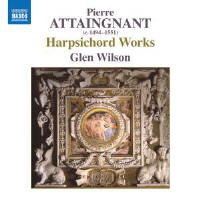Texte paru dans: / Appeared in: Naxos 8572999 |
|
|
Reviewer: Bertil
van Boer As a music publisher, Pierre Attaingnant is well known both for his sets of instrumental pieces and chansons during the middle of the 16th century. He also improved upon the Petrucci notation fonts, making things more readable, which is a major step in unifying the printing of music for later generations. As much as we know his publications, not much is known about Attaingnant himself. He seems to have been a bookseller in Paris about 1514, beginning his career as a publisher about a decade or so later. By 1538 he received a royal privilege, but thereafter he sort of disappears from history somewhere around 1551. Best known for his work with Clément Janequin, he also pioneered the printing of instrumental works. It is not known whether he was actually a composer, but he certainly must have been well versed in music to have focused as he did on music publication. While his vocal and consort works are known, it is interesting to note that he also produced some of the first keyboard works. Clavichords date from about a century or more earlier, as do harpsichords, and there are developments that probably occurred during his lifetime, such as the English virginal. While a history of keyboard instruments is a fascinating subject, the fact that these works, contained in about six volumes, have survived intact indicates that Attaingnant must have seen a potential market for published music for them. This recording contains about 30 of the odd works, many anonymous (perhaps by Attaingnant himself) and paraphrases of numerous dances. Since these are mostly short and even perfunctory, the disc has been filled out with other works from the same period, mainly from various fragmentary sources. The result is a compendium of what might have been performed in French households of the period that were rich or fortunate enough to have afforded keyboard instruments. As the Attaingnant collection does not constitute a cohesive body, it is not surprising that one finds numerous arrangements of vocal works, the bulk of which are drawn from the chansons of the time. Janequin, of course, appears, as does his equally talented colleague Claude de Sermisy, and there are even a couple of sacred works (a Magnificat and a motet by Jean de la Fage). The last (Aspice Domine) is in the manner of Heinrich Isaac, polyphonically animated homophony that seems less contrapuntal than one might expect, almost as if it were a secular song. Sermisy’s D’ou vient cela has some rather rich harmonies, but the line is decidedly old-fashioned, with modal cadences and a repetitious set of lines that practically begs for the text. The popular song Ma bouche rit is a bit plodding, but there is some simple imitation in this rendition. The more advanced works, however, are the various dances. The “Swiss” (La Svizzera) that follows is lively and leaps about, while the saltarello couplet contains rather interesting lines that fold in upon themselves almost like a round. The Galliarde No. 22, entitled as a basse dance, seems quite folk-like, with a steady ostinato that is reminiscent of bagpipes (the French version, of course), and the two branles in the first section are also apparently drawn from folk dances with their short phrases and repetitions. The remainder of the non-Attaingnant repertory is drawn from various other sources, many manuscript. The Pierre Sandrin chanson Quant j’eu cogneu is quite moody, but it too has an origin in the strophic dances of the period, while the 39th Fantasy by Eustache du Caurroy is a lengthy set of variations (or rather improvisations) in the vein of Jan Sweelinck, and with this and the concluding paraphrase by Guillaume Costeley one enters the world of the early Baroque keyboard. The latter has a nice theme that reflects a leap of a diminished seventh, and though the counterpoint is somewhat subdued, it reflects the trend towards taking recognizable themes and expounding upon them. The performance on an Italian harpsichord by Glen Wilson is fine, though he has to deal with some odd harmonies and sources that are, as he notes, not well proofread. This results in an occasional harmonic quirk, and the pace of the performance is often rather stately, not to say a bit ponderous. The music itself is hardly that exciting, and the registrations here seem to underscore this. One should not expect too much from keyboard music of this period, as it played perhaps third banana to the vocal music and instrumental consorts. Still, it is good to have this as an historical record of not only Attaingnant’s contributions to the early keyboard repertory, but also of a demonstration that the keyboard was actively participating in musical endeavors of the time. | |
|
|
|
|
|
|
|
Cliquez l'un ou l'autre
bouton pour découvrir bien d'autres critiques de CD |
|




